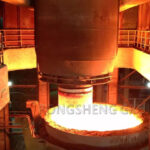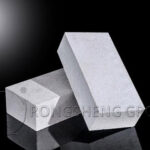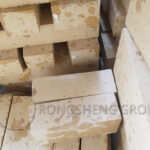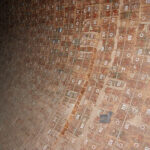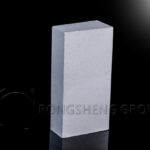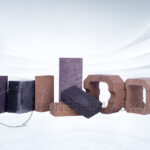MgO-C bricks are mainly used in refining ladle furnaces and ladles, primarily in areas such as the clearance and slag line. Depending on the operating conditions, the refractory materials used in these areas must be resistant to high temperatures, thermal shock, and mechanical corrosion caused by molten slag. Therefore, magnesia-chromium refractories were previously used in these areas. However, considering the environmental pollution of chromium, its usage has decreased, and magnesia-carbon bricks are now preferred.
During the preheating process, magnesia-carbon bricks in new ladles are severely damaged, resulting in a loose decarburized layer that can reach 30-60 mm in thickness. This layer is washed away during the pouring of molten steel, carrying magnesia particles into the slag. Clearly, preventing the carbon in the magnesia-carbon bricks from burning off during preheating is a crucial step in improving the service life of magnesia-carbon bricks in the ladle clearance and slag line areas. Technical measures, besides incorporating composite antioxidants into the magnesia-carbon bricks, include, crucially, covering the surface of the magnesia-carbon bricks, carbon magnesia bricks with an alkaline, low-melting-point glassy liquid after lining to protect the carbon in the magnesia-carbon bricks from burning off during the ladle preheating process.
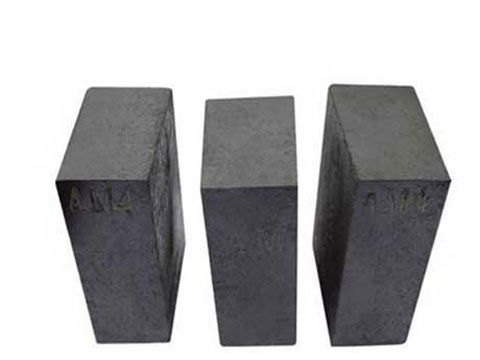
Application of Magnesia-Carbon Bricks in Converter Linings
Due to the different operating conditions in various parts of the converter working lining, the performance of magnesia-carbon bricks varies. The furnace mouth area is constantly impacted by both cold and hot molten steel, so the refractory material used at the furnace mouth must be resistant to the erosion of high-temperature slag and high-temperature exhaust gases, and should not easily accumulate steel and be easy to clean. The furnace cap area is subjected not only to severe slag erosion but also to rapid temperature changes, as well as the combined effects of high-temperature airflow due to carbon oxidation and the erosion of dust and high-temperature exhaust gases. Therefore, magnesia-carbon bricks with strong slag erosion resistance and spalling resistance are used. The charging side requires magnesia-carbon bricks to have not only high slag erosion resistance but also high high-temperature strength and good spalling resistance. Therefore, high-strength magnesia-carbon bricks, carbon magnesia bricks with added metallic antioxidants are typically used. Studies have shown that magnesia-carbon bricks with added aluminum have lower high-temperature strength at lower temperatures than those with composite additions of aluminum and silicon, but their high-temperature strength increases at higher temperatures. The slag line is the interface between the furnace lining refractory material, high-temperature molten slag, and furnace gas, and is the area most severely affected by slag erosion. Therefore, it is necessary to construct the slag line area using magnesia-carbon bricks with excellent resistance to slag erosion, and magnesia-carbon bricks with a high carbon content are required.
The Use of Magnesia-Carbon Bricks in Electric Arc Furnaces
Currently, almost all electric arc furnace walls are constructed using magnesia-carbon bricks; therefore, the lifespan of these bricks determines the overall lifespan of the electric arc furnace. The main factors determining the quality of magnesia-carbon bricks for electric arc furnaces include the purity of the magnesia source (MgO), the types of impurities, the grain bonding state of the periclase, and the grain size. The purity, degree of crystallinity, and flake size of the flake graphite, the carbon introduction source, are also crucial. Thermosetting phenolic resin is typically used as a binder, with the main influencing factors being the amount added and the residual carbon content. It has been proven that adding antioxidants to magnesia-carbon bricks can alter and improve their matrix structure. However, under normal operating conditions of the electric arc furnace, antioxidants are not a necessary component of magnesia-carbon bricks. They are only essential for use in electric arc furnaces with high FeOn slag, such as those using direct reduced iron, areas with irregular oxidation, and hot spots. In these cases, adding various metallic antioxidants becomes a crucial component of magnesia-carbon bricks.
The corrosion behavior of magnesia-carbon bricks, carbon magnesia bricks at the slag line is characterized by the formation of a distinct reactive dense layer and a decarburized loose layer. The reaction compaction zone, also known as the slag invasion zone, is the erosion area where high-temperature liquid slag penetrates into the interior of the magnesia-carbon brick after decarburization, forming numerous pores. Within this zone, FeOn in the slag is reduced to metallic iron, and even the dissolved phase in MgO and intergranular Fe2O3 are reduced to metallic iron. The depth of slag penetration into the brick is mainly determined by the thickness of the decarburized porous layer, usually ending where residual graphite remains. Under normal circumstances, the decarburized layer in magnesia-carbon bricks is relatively thin due to the presence of graphite.
Electric furnace tapping has two methods: tilting tapping and bottom tapping. When tilting tapping is used, magnesia-carbon bricks are generally not used. Instead, Al2O3 or ZrO2 materials are selected, with the addition of non-oxidizing compounds such as C, SiC, and Si3N4. When bottom tapping is used, the tapping opening consists of an outer layer of bricks and an inner tube brick. The taphole at the furnace bottom uses magnesia-carbon brick tubes. The diameter of the tubes is determined by factors such as furnace capacity and tapping time, generally with an inner diameter of 140-260 mm.
A steel plant’s electric arc furnace has initially achieved good results by using medium- and low-grade magnesia-carbon bricks at the taphole, replacing the previously used sintered magnesia bricks on both sides of the copper taphole. The furnace lifespan has increased from approximately 60 heats to more than double. After implementation, the magnesia-carbon bricks at the slag line remain relatively intact and do not adhere to slag. No furnace repairs are needed at the slag line, reducing labor intensity and improving steel purity and productivity.
Application of Alumina-Magnesium-Carbon Bricks in Steel Ladles
MgO-C bricks are mainly used in refining steel ladle furnaces and ladles, primarily in areas such as the clearance zone and slag line. Depending on operating conditions, the refractory materials used in these areas must be resistant to high temperatures, thermal shock, and mechanical corrosion caused by molten slag erosion. Therefore, magnesia-chromium refractories were previously used in these areas; however, due to the environmental pollution of chromium, its usage has been reduced, and magnesia-carbon bricks are now the preferred choice.
During the preheating process, magnesia-carbon bricks, carbon magnesia bricks in new steel ladles are severely damaged, resulting in a loose decarburized layer that can reach 30-60 mm in thickness. This layer is washed away during the pouring of molten steel, carrying magnesia particles into the molten slag. Clearly, preventing the carbon in the magnesia-carbon bricks from burning off during preheating is a crucial step in extending the service life of magnesia-carbon bricks in the clearance zone and slag line areas of the ladle. The key technical measure, in addition to adding a composite antioxidant to the magnesia-carbon bricks, is to cover the surface of the magnesia-carbon bricks with an alkaline low-melting-point glass phase liquid after lining, so as to protect the carbon in the magnesia-carbon bricks from being burned off during the preheating process of the ladle.

